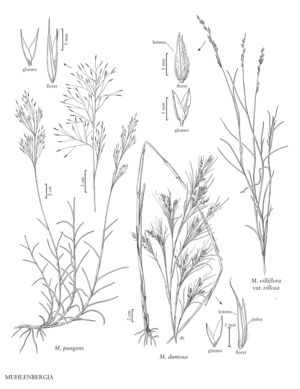Difference between revisions of "Muhlenbergia villiflora"
FNA>Volume Importer |
imported>Volume Importer |
||
| (5 intermediate revisions by 2 users not shown) | |||
| Line 18: | Line 18: | ||
|distribution=N.Mex.;Tex. | |distribution=N.Mex.;Tex. | ||
|discussion=<p>In the United States, <i>Muhlenbergia villiflora</i> grows in open ground with alkaline to calcareous soils and on gypsum rock flats, at elevations of 600-1200 m. It usually forms small, isolated populations.</p><!-- | |discussion=<p>In the United States, <i>Muhlenbergia villiflora</i> grows in open ground with alkaline to calcareous soils and on gypsum rock flats, at elevations of 600-1200 m. It usually forms small, isolated populations.</p><!-- | ||
| − | --><p>Plants in the United States belong to <i>Muhlenbergia villiflora</i> < | + | --><p>Plants in the United States belong to <i>Muhlenbergia villiflora</i> <i></i>var.<i> villosa</i> (Swallen) Morden. This variety differs from <i>M. villiflora</i> Hitchc. var. villiflora, which grows in Mexico, in its longer spikelets (1.8-2.5 mm versus 1.4-2.3 mm) and preference for calcareous, rather than gypsiferous, soils.</p> |
|tables= | |tables= | ||
|references= | |references= | ||
| Line 27: | Line 27: | ||
-->{{#Taxon: | -->{{#Taxon: | ||
name=Muhlenbergia villiflora | name=Muhlenbergia villiflora | ||
| − | |||
|authority=Hitchc. | |authority=Hitchc. | ||
|rank=species | |rank=species | ||
| Line 34: | Line 33: | ||
|basionyms= | |basionyms= | ||
|family=Poaceae | |family=Poaceae | ||
| + | |illustrator=Linda A. Vorobik;Annaliese Miller | ||
| + | |illustration copyright=Utah State University | ||
|distribution=N.Mex.;Tex. | |distribution=N.Mex.;Tex. | ||
|reference=None | |reference=None | ||
| Line 39: | Line 40: | ||
|publication year= | |publication year= | ||
|special status= | |special status= | ||
| − | |source xml=https:// | + | |source xml=https://bitbucket.org/aafc-mbb/fna-data-curation/src/200273ad09963decb8fc72550212de541d86569d/coarse_grained_fna_xml/V25/V25_747.xml |
|subfamily=Poaceae subfam. Chloridoideae | |subfamily=Poaceae subfam. Chloridoideae | ||
|tribe=Poaceae tribe Cynodonteae | |tribe=Poaceae tribe Cynodonteae | ||
Latest revision as of 18:58, 11 May 2021
Plants perennial; rhizomatous, not cespitose. Culms 4-30 cm tall, to 2 mm thick, erect; internodes smooth or nodulose. Sheaths shorter than the internodes, smooth to nodulose; ligules 0.4-1.5 mm, membranous, acute, erose; blades 0.7-3 cm long, 0.2-1.2 mm wide, arcuate-spreading, tightly involute, glabrous abaxially, hirtellous adaxially. Panicles 1-5 cm long, 0.1-0.5 cm wide, contracted, not dense, usually completely exserted; branches 0.2-1.1 cm, appressed to ascending; pedicels 0.1-1.2 mm, setulose. Spikelets 1.4-2.5 mm. Glumes equal, 0.6-1.8 mm, 1/2 - 2/3 as long as the lemmas, glabrous, 1(2, 3)-veined, acute, unawned; lemmas 1.4-2.5 mm, lanceolate, green or purplish, midveins and margins densely villous for most of their length, hairs 0.4-1 mm, apices acute, unawned, sometimes mucronate, mucros to 0.5 mm; paleas 1.4-2.3 mm, lanceolate, intercostal region densely villous, apices acute; anthers 0.9-1.4 mm, yellow, dark green, or purple. Caryopses 1-1.4 mm, ellipsoid to fusiform, dark brown. 2n = 20, 40.
Discussion
In the United States, Muhlenbergia villiflora grows in open ground with alkaline to calcareous soils and on gypsum rock flats, at elevations of 600-1200 m. It usually forms small, isolated populations.
Plants in the United States belong to Muhlenbergia villiflora var. villosa (Swallen) Morden. This variety differs from M. villiflora Hitchc. var. villiflora, which grows in Mexico, in its longer spikelets (1.8-2.5 mm versus 1.4-2.3 mm) and preference for calcareous, rather than gypsiferous, soils.
Selected References
None.
